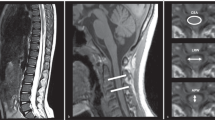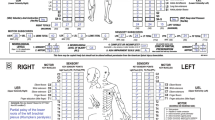Abstract
Study design:
Retrospective review.
Objectives:
To identify relationships between lower extremity innervation and level of injury, mechanism of injury, and age at injury in a pediatric population with spinal cord injury (SCI). Secondarily, relationships between innervation and completeness of injury, time since injury, race, and sex were evaluated.
Setting:
Pediatric orthopedic referral hospital, Philadelphia, Pennsylvania.
Methods:
Records of 190 subjects, ages 1–21 years, were reviewed. Data collected from the medical record included lower extremity muscle innervation, American Spinal Injury Association (ASIA) level and class, mechanism of injury, age at injury, time since injury, race, and sex. To determine innervation, lower extremity muscles had been tested using surface electrical stimulation and identified as being innervated or denervated. If a muscle responded weakly, strength duration testing was performed. For analysis via logistic regression, subjects were grouped based upon level and mechanism of injury.
Results:
A relationship (P<0.0001) was found between ASIA level and lower extremity innervation of all muscles and between length of time since injury and lower extremity innervation for some muscles. Following multiple logistic regression, only ASIA level remained as an independent predictor of lower extremity innervation status.
Conclusion:
Our results show that lower extremity innervation does differ based on the level of the injury. Denervation began to be seen with injuries in the lower thoracic region and more predominantly with injuries in the lumbar region. This supports our hypothesis that the incidence of lower motor neuron injuries would increase as injuries became more caudal. Our hypotheses of a relationship between innervation status and mechanism of injury and age at injury were not supported. This information is important in determining treatment strategies, eligibility for electrical stimulation techniques, and potential regenerative strategies.
Sponsorship:
This study was funded by Shriners Hospitals for Children, Grant #8530.
Similar content being viewed by others
Log in or create a free account to read this content
Gain free access to this article, as well as selected content from this journal and more on nature.com
or
References
Doherty JG, Burns AS, O'Ferrall DM, Ditunno Jr JF . Prevalence of upper motor neuron vs lower motor neuron lesions in complete lower thoracic and lumbar spinal cord injuries. J Spinal Cord Med 2002; 25: 289–292.
Brissot R et al. Clinical experience with functional electrical stimulation-assisted gait with Parastep in spinal cord-injured patients. Spine 2000; 25: 501–508.
Kralj A, Bajd T, Turk R, Krajnik J, Benko H . Gait restoration in paraplegic patients: a feasibility demonstration using multichannel surface electrode FES. J Rehabil R D 1983; 20: 3–20.
Klose KJ et al. Evaluation of a training program for persons with SCI paraplegia using the Parastep 1 ambulation system: part 1. Ambulation performance and anthropometric measures. Arch Phys Med Rehabil 1997; 78: 789–793.
Smith BT . Functional electrical stimulation. Top Spinal Cord Rehabil 1997; 3: 56–69.
Chae J, Hart R . Comparison of discomfort associated with surface and percutaneous intramuscular electrical stimulation for persons with chronic hemiplegia. Am J Phys Med Rehabil 1998; 77: 516–522.
Peckham PH . Functional electrical stimulation: current status and future prospects of applications to the neuromuscular system in spinal cord injury. Paraplegia 1987; 25: 279–288.
Bonaroti D, Akers JM, Smith BT, Mulcahey MJ, Betz RR . Comparison of functional electrical stimulation to long leg braces for upright mobility for children with complete thoracic level spinal injuries. Arch Phys Med Rehabil 1999; 80: 1047–1053.
Moynahan M et al. Home use of a functional electrical stimulation system for standing and mobility in adolescents with spinal cord injury. Arch Phys Med Rehabil 1996; 77: 1005–1013.
Shimada Y, Sato K, Kagaya H, Konishi N, Miyamoto S, Matsunaga T . Clinical use of percutaneous intramuscular electrodes for functional electrical stimulation. Arch Phys Med Rehabil 1996; 77: 1014–1018.
Mulcahey MJ, Betz RR . Upper and lower extremity applications of functional electrical stimulation: a decade of research with children and adolescents with spinal injuries. Pediatric Phys Ther 1997; 9: 113–122.
Kobetic R, Marsolais EB . Synthesis of paraplegic gait with multichannel functional neuromuscular stimulation. IEEE Trans Rehabil Eng 1994; 2: 66–79.
Johnston TE, Betz RR, Smith BT, Mulcahey MJ . Implanted functional electrical stimulation: an alternative for standing and walking in pediatric spinal cord injury. Spinal Cord 2003; 41: 144–152.
McDonald JW et al. Late recovery following spinal cord injury. Case report and review of the literature. J Neurosurg 2002; 97(Suppl): 252–265.
Faghri PD, Glaser RM, Figoni SF . Functional electrical stimulation leg cycle ergometer exercise: training effects on cardiorespiratory responses of spinal cord injured subjects at rest and during submaximal exercise. Arch Phys Med Rehabil 1992; 73: 1085–1093.
Mutton DL, Scremin AM, Barstow TJ, Scott MD, Kunkel CF, Cagle TG . Physiologic responses during functional electrical stimulation leg cycling and hybrid exercise in spinal cord injured subjects. Arch Phys Med Rehabil 1997; 78: 712–718.
Hooker SP et al. Physiologic effects of electrical stimulation leg cycle exercise training in spinal cord injured persons. Arch Phys Med Rehabil 1992; 73: 470–476.
Hjeltnes N, Aksnes AK, Birkeland KI, Johansen J, Lannem A, Wallberg-Henriksson H . Improved body composition after 8 wk of electrically stimulated leg cycling in tetraplegic patients. Am J Physiol 1997; 273(Part 2): R1072–R1079.
Raymond J, Davis GM, Climstein M, Sutton JR . Cardiorespiratory responses to arm cranking and electrical stimulation leg cycling in people with paraplegia. Med Sci Sports Exerc 1999; 31: 822–828.
McComas AJ . Skeletal Muscle: Form and Function. Human Kinetics: Champaign, IL 1996.
Mulcahey MJ, Smith BT, Betz RR . Evaluation of the lower motor neuron integrity of upper extremity muscles in high level spinal cord injury. Spinal Cord 1999; 37: 585–591.
Chuang TY, Cheng H, Chan RC, Chiang SC, Guo WY . Neurourologic findings in patients with traumatic thoracolumbar vertebra junction lesions. Arch Phys Med Rehabil 2001; 82: 375–379.
Triolo RJ, Betz RR, Mulcahey MJ, Gardner ER . Application of functional neuromuscular stimulation to children with spinal cord injuries: candidate selection for upper and lower extremity research. Paraplegia 1994; 32: 824–843.
Waters RL, Adkins RH . Firearm versus motor vehicle related spinal cord injury: preinjury factors, injury characteristics, and initial outcome comparisons among ethnically diverse groups. Arch Phys Med Rehabil 1997; 78: 150–155.
McKinley WO, Huang ME, Brunsvold KT . Neoplastic versus traumatic spinal cord injury: an outcome comparison after inpatient rehabilitation. Arch Phys Med Rehabil 1999; 80: 1253–1257.
Somers M . Spinal Cord Injury Functional Rehabilitation 2nd ed. Prentice-Hall: Upper Saddle River, NJ 2001.
Proctor MR . Spinal cord injury. Crit Care Med 2002; 30(Suppl): S489–S499.
Cirak B, Ziegfeld S, Knight VM, Chang D, Avellino AM, Paidas CN . Spinal injuries in children. J Pediatr Surg 2004; 39: 607–612.
Hiersemenzel LP, Curt A, Dietz V . From spinal shock to spasticity: neuronal adaptations to a spinal cord injury. Neurology 2000; 54: 1574–1582.
Author information
Authors and Affiliations
Rights and permissions
About this article
Cite this article
Johnston, T., Greco, M., Gaughan, J. et al. Patterns of lower extremity innervation in pediatric spinal cord injury. Spinal Cord 43, 476–482 (2005). https://doi.org/10.1038/sj.sc.3101741
Published:
Issue date:
DOI: https://doi.org/10.1038/sj.sc.3101741
Keywords
This article is cited by
-
Nervous system modulation through electrical stimulation in companion animals
Acta Veterinaria Scandinavica (2021)



